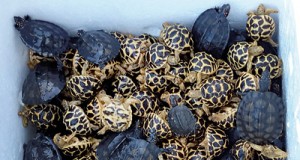News
Tortoise smuggling racket stretches to IndiaBy Malaka Rodrigo
View(s):Investigations by the Sunday Times have revealed that as well as the two detections of live tortoises being smuggled to Kuala Lumpur in July through Colombo airport, there had been at least three separate attempts in the same month to smuggle tortoises from Chennai to Malaysia.

Photo courtesy Sri Lanka Customs
Sri Lanka Custom’s Biodiversity Protection Unit on Tuesday seized 488 little tortoises being smuggled out through Bandaranaike International Airport, the second time this month that such a seizure had been made.
Conducting a check on a package marked as containing “Live Crabs”, Customs found polythene-wrapped little hard shells. A closer look revealed heads popping out of some of these shells, showing that there were live tortoises concealed in the package.
There were seven such packages bound for Kuala Lumpur in Malaysia, sent by a private firm in Yakkala, according to Customs spokesperson Lesley Gamini.
The 488 freshwater tortoises had each been carefully wrapped on polythene to prevent them from moving around. Among them were little star tortoises (tharaka ibba) and black turtles (gal ibba) that are native to Sri Lanka, as well as another species not native to this country.
Tortoises are not among the kind of illegal cargo being seized regularly by Customs at the airport but in July there were two such detections. On July 3, the Customs Biodiversity Protection Unit made a similar detention of 124 little tortoises being smuggled out.
These tortoises were concealed in the checked-in baggage of a man living in Negombo. He was arrested at the airport departure lounge. These tortoises too were bound for Kuala Lumpur, raising concerns of organised crime.Investigations by this paper show that, astonishingly, Indian Customs officers at Chennai Airport also made multiple detections of live tortoises on three occasions during July. The detections were made on July 2, 9 and 25, respectively recovering 60, 41 and 50 little tortoises.
All these shipments were also bound for Kuala Lumpur.The former head of the Customs’ Biodiversity Protection Unit, Samantha Gunasekera, said attempts to smuggle large numbers of wildlife often coincided with international animal/reptile fairs such as the fair in Frankfurt. Mr. Gunasekara, with his decades of experience in Customs, said he had observed an increase in reptile smuggling every year at the same periods.
Raising tortoises as pets is popular in many countries and it is believed that these tortoises were being smuggled out to be sold as pets. Sadly, however, they do not make suitable pets and nine out of 10 die within four years because their owners are unable to provide the environmental conditions they need to survive, according to a report by Britain’s Royal Society for the Prevention of Cruelty to Animals.
The Convention of International Trade of Endangered Species (CITES) bans trade in many turtle and tortoise species and there are strict regulations for others.Sri Lanka is home to three tortoise species, the star tortoise, the black turtle (also known as the hard-shelled black terrapin) and the flapshell turtle, also known as the soft-shelled terrapin (kiri Ibba). The last has recently been recognised as a species endemic to Sri Lanka.
Their conservation status indicates that they are not threatened yet. We are, however, seeing fewer tortoises compared to a few decades ago, and if an organised export trade in “wild caught” tortoises for pets is allowed to flourish it will affect Sri Lanka’s wild tortoise population.
The existence of a non-native species among the smuggling shipment detected by Customs last month indicates a possibility of trans-boundary smuggling.
Turtle, tortoise or terrapin?
They are all scaly, egg-laying reptiles but are called different names; turtles, tortoises, and terrapins look similar to the general public but are assigned to different species on the basis of habitat and behaviour.
Turtles lives in water and have webbed feet. The sea turtle’s feet evolved as flippers, helping them to swim. Tortoises live on land. They do not have webbed feet as they adapted to a life on land and have rounded and stumpy feet for walking.
Terrapins live on both on land and in water, but always near water.
Among Sri Lankan species, the star tortoise is, without confusion, always called a tortoise but the other two species are often called either turtle or terrapin.

